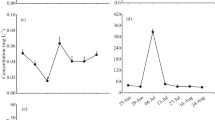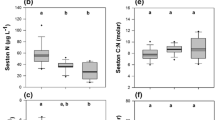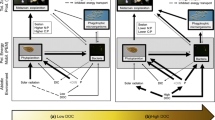Abstract
Ecosystems are generally linked via fluxes of nutrients and energy across their boundaries. For example, freshwater ecosystems in temperate regions may receive significant inputs of terrestrially derived carbon via autumnal leaf litter. This terrestrial particulate organic carbon (POC) is hypothesized to subsidize animal production in lakes, but direct evidence is still lacking. We divided two small eutrophic lakes each into two sections and added isotopically distinct maize litter to the treatment sections to simulate increased terrestrial POC inputs via leaf litter in autumn. We quantified the reliance of aquatic consumers on terrestrial resources (allochthony) in the year subsequent to POC additions by applying mixing models of stable isotopes. We also estimated lake-wide carbon (C) balances to calculate the C flow to the production of the major aquatic consumer groups: benthic macroinvertebrates, crustacean zooplankton, and fish. The sum of secondary production of crustaceans and benthic macroinvertebrates supported by terrestrial POC was higher in the treatment sections of both lakes. In contrast, total secondary and tertiary production (supported by both autochthonous and allochthonous C) was higher in the reference than in the treatment sections of both lakes. Average aquatic consumer allochthony per lake section was 27–40%, although terrestrial POC contributed less than about 10% to total organic C supply to the lakes. The production of aquatic consumers incorporated less than 5% of the total organic C supply in both lakes, indicating a low ecological efficiency. We suggest that the consumption of terrestrial POC by aquatic consumers facilitates a strong coupling with the terrestrial environment. However, the high autochthonous production and the large pool of autochthonous detritus in these nutrient-rich lakes make terrestrial POC quantitatively unimportant for the C flows within food webs.





Similar content being viewed by others
References
Abelho M. 2001. From litterfall to breakdown in streams: a review. ScientificWorldJournal 17:656–80.
Attermeyer K, Premke K, Hornick T, Hilt S, Grossart HP. 2013. Ecosystem-level studies of terrestrial carbon reveal contrasting bacterial metabolism in different aquatic habitats. Ecology 94:2754–66.
Babler AL, Pilati A, Vanni MJ. 2011. Terrestrial support of detritivorous fish populations decreases with watershed size. Ecosphere . doi:10.1890/ES11-00043.1.
Bade DL, Carpenter SR, Cole JJ, Hanson PC, Hesslein RH. 2004. Controls of delta C-13-DIC in lakes: geochemistry, lake metabolism, and morphometry. Limnol Oceanogr 49:1160–72.
Bade DL, Pace ML, Cole JJ, Carpenter SR. 2006. Can algal photosynthetic inorganic carbon isotope fractionation be predicted in lakes using existing models? Aquat Sci 68:142–53.
Bartels P, Cucherousset J, Gudasz C, Jansson M, Karlsson J, Persson L, Premke K, Rubach A, Steger K, Tranvik LJ, Eklov P. 2012. Terrestrial subsidies to lake food webs: an experimental approach. Oecologia 168:807–18.
Benfield EF. 1996. Leaf breakdown in stream ecosystems. In: Hauer FR, Lamberti GA, Eds. Methods in stream ecology. San Diego: Academic Press. p 579–89.
Berggren M, Strom L, Laudon H, Karlsson J, Jonsson A, Giesler R, Bergstrom AK, Jansson M. 2010. Lake secondary production fueled by rapid transfer of low molecular weight organic carbon from terrestrial sources to aquatic consumers. Ecol Lett 13:870–80.
Berggren M, Ziegler SE, St-Gelais NF, Beisner BE, del Giorgio PA. 2014. Contrasting patterns of allochthony among three major groups of crustacean zooplankton in boreal and temperate lakes. Ecology 95:1947–59.
Boit A, Gaedke U. 2014. Benchmarking successional progress in a quantitative food web. PLoS One. doi:10.1371/journal.pone.0090404.
Brauns M, Gücker B, Wagner C, Garcia XF, Walz N, Pusch MT. 2011. Human lakeshore development alters the structure and trophic basis of littoral food webs. J Appl Ecol 48:916–25.
Brett MT, Kainz MJ, Taipale SJ, Seshan H. 2009. Phytoplankton, not allochthonous carbon, sustains herbivorous zooplankton production. Proc Natl Acad Sci USA 106:21197–201.
Brothers SM, Ahilt S, Meyer S, Köhler J. 2013a. Plant community structure determines primary productivity in shallow, eutrophic lakes. Freshw Biol 58:2264–76.
Brothers SM, Hilt S, Attermeyer K, Grossart HP, Kosten S, Lischke B, Mehner T, Meyer N, Scharnweber K, Köhler J. 2013b. A regime shift from macrophyte to phytoplankton dominance enhances carbon burial in a shallow, eutrophic lake. Ecosphere 4:137. doi:10.1890/ES13-00247.1.
Carpenter SR. 1989. Replication and treatment strength in whole-lake experiments. Ecology 70:453–63.
Carpenter SR, Cole JJ, Pace ML, Van de Bogert M, Bade DL, Bastviken D, Gille CM, Hodgson JR, Kitchell JF, Kritzberg ES. 2005. Ecosystem subsidies: terrestrial support of aquatic food webs from C-13 addition to contrasting lakes. Ecology 86:2737–50.
Cole JJ, Carpenter SR, Kitchell J, Pace ML, Solomon CT, Weidel B. 2011. Strong evidence for terrestrial support of zooplankton in small lakes based on stable isotopes of carbon, nitrogen, and hydrogen. Proc Natl Acad Sci USA 108:1975–80.
Cole JJ, Carpenter SR, Pace ML, Van de Bogert MC, Kitchell JL, Hodgson JR. 2006. Differential support of lake food webs by three types of terrestrial organic carbon. Ecol Lett 9:558–68.
Dolbeth M, Cusson M, Sousa R, Pardal MA. 2012. Secondary production as a tool for better understanding of aquatic ecosystems. Can J Fish Aquat Sci 69:1230–53.
Dumont HJ, Vandevelde I, Dumont S. 1975. Dry weight estimate of biomass in a selection of Cladocera, Copepoda and Rotifera from plankton, periphyton and benthos of continental waters. Oecologia 19:75–97.
Francis TB, Schindler DE, Holtgrieve GW, Larson ER, Scheuerell MD, Semmens BX, Ward EJ. 2011. Habitat structure determines resource use by zooplankton in temperate lakes. Ecol Lett 14:364–72.
Fraser CM. 1916. Growth of the spring salmon. Transactions of the Pacific Fisheries Society Seattle, pp. 29–39.
Gaedke U. 1992. The size distribution of plankton biomass in a large lake and its seasonal variability. Limnol Oceanogr 37:1202–20.
Gaedke U, Straile D. 1994. Seasonal changes of trophic transfer efficiencies in a plankton food web derived from biomass size distributions and network analysis. Ecol Model 75:435–45.
Haney JF, Hall DJ. 1973. Sugar-coated Daphnia: a preservation technique for Cladocera. Limnol Oceanogr 18:331–3.
Hilt S, Wanke T, Scharnweber K, Brauns M, Syvaranta J, Brothers S, Gaedke U, Kohler J, Lischke B, Mehner T. 2015. Contrasting response of two shallow eutrophic cold temperate lakes to a partial winterkill of fish. Hydrobiologia 749:31–42.
Jones SE, Solomon CT, Weidel BC. 2012. Subsidy or subtraction: how do terrestrial inputs influence consumer production in lakes? Freshw Rev 5:37–49.
Karlsson J. 2007. Different carbon support for respiration and secondary production in unproductive lakes. Oikos 116:1691–6.
Karlsson J, Ask J, Jansson M. 2008. Winter respiration of allochthonous and autochthonous organic carbon in a subarctic clear-water lake. Limnol Oceanogr 53:948–54.
Karlsson J, Berggren M, Ask J, Byström P, Jonsson A, Laudon H, Jansson M. 2012. Terrestrial organic matter support of lake food webs: evidence from lake metabolism and stable hydrogen isotopes of consumers. Limnol Oceanogr 57:1042–8.
Kelly PT, Solomon CT, Weidel BC, Jones SE. 2014. Terrestrial carbon is a resource, but not a subsidy, for lake zooplankton. Ecology 95:1236–42.
Kritzberg ES, Cole JJ, Pace ML, Graneli W, Bade DL. 2004. Autochthonous versus allochthonous carbon sources of bacteria: results from whole-lake C-13 addition experiments. Limnol Oceanogr 49:588–96.
Kritzberg ES, Cole JJ, Pace MM, Graneli W. 2005. Does autochthonous primary production drive variability in bacterial metabolism and growth efficiency in lakes dominated by terrestrial C inputs? Aquat Microb Ecol 38:103–11.
Larsen S, Andersen T, Hessen DO. 2011. Climate change predicted to cause severe increase of organic carbon in lakes. Glob Change Biol 17:1186–92.
Lee RM. 1920. A review of the methods of age and growth determination of juvenile fish in the littoral area of a shallow lake. Fish Investig Lond Ser 4:32.
Marcarelli AM, Baxter CV, Mineau MM, Hall RO. 2011. Quantity and quality: unifying food web and ecosystem perspectives on the role of resource subsidies in freshwaters. Ecology 92:1215–25.
Marczak LB, Thompson RM, Richardson JS. 2007. Meta-analysis: trophic level, habitat, and productivity shape the food web effects of resource subsidies. Ecology 88:140–8.
Masese FO, Abrantes KG, Gettel GM, Bouillon S, Irvine K, McClain ME. 2015. Are large herbivores vectors of terrestrial subsidies for riverine food webs? Ecosystems 18:686–706.
Mehner T, Ihlau J, Dörner H, Hölker F. 2005. Can feeding of fish on terrestrial insects subsidize the nutrient pool of lakes? Limnol Oceanogr 50:2022–31.
Moore JC, Berlow EL, Coleman DC, de Ruiter PC, Dong Q, Hastings A, Johnson NC, McCann KS, Melville K, Morin PJ, Nadelhoffer K, Rosemond AD, Post DM, Sabo JL, Scow KM, Vanni MJ, Wall DH. 2004. Detritus, trophic dynamics and biodiversity. Ecol Lett 7:584–600.
Nakano S, Murakami M. 2001. Reciprocal subsidies: dynamic interdependence between terrestrial and aquatic food webs. Proc Natl Acad Sci USA 98:166–70.
Parnell AC, Phillips DL, Bearhop S, Semmens BX, Ward EJ, Moore JW, Jackson AL, Grey J, Kelly DJ, Inger R. 2013. Bayesian stable isotope mixing models. Environmetrics 24:387–99.
Petersen RC, Cummins KW. 1974. Leaf processing in a woodland stream. Freshw Biol 4:343–68.
Phillips DL, Koch PL. 2002. Incorporating concentration dependence in stable isotope mixing models. Oecologia 130:114–25.
Plante C, Downing JA. 1989. Production of freshwater invertebrate populations in lakes. Can J Fish Aquat Sci 46:1489–98.
Polis GA, Anderson WB, Holt RD. 1997. Towards an integration of landscape and food web ecology: the dynamics of spatially subsidized food webs. Annu Rev Ecol Syst 28:289–316.
Post DM. 2002. Using stable isotopes to estimate trophic position: models, methods, and assumptions. Ecology 83:703–18.
R Development Core Team. 2012. R: a language and environment for statistical computing. Vienna: R Foundation for Statistical Computing.
Ricker WE. 1975. Computation and interpretation of biological statistics of fish populations. Bull Fish Res Board Can 191:1–382.
Rudnick S, Lewandowski J, Nützmann G. 2015. Investigating groundwater–lake interactions by hydraulic heads and a water balance. Groundwater 53:227–37.
Scharnweber K, Syväranta J, Hilt S, Brauns M, Vanni MJ, Brothers SM, Köhler J, Knezevic-Jaric J, Mehner T. 2014a. Whole-lake experiments reveal the fate of terrestrial particulate organic carbon in benthic food webs of shallow lakes. Ecology 95:1496–505.
Scharnweber K, Vanni MJ, Hilt S, Syväranta J, Mehner T. 2014b. Boomerang ecosystem fluxes: organic carbon inputs from land to lakes are returned to terrestrial food webs via aquatic insects. Oikos 123:1439–48.
Stock BC, Semmens BX. 2013. MixSIAR GUI User Manual, version 2.1.2.
Stockwell JD, Johannson OE. 1997. Temperature-dependent allometric models to estimate zooplankton production in temperate freshwater lakes. Can J Fish Aquat Sci 54:2350–60.
Taipale S, Kankaala P, Jones RI. 2007. Contributions of different organic carbon sources to Daphnia in the pelagic foodweb of a small polyhumic lake: results from mesocosm (DIC)-C-13-additions. Ecosystems 10:757–72.
Taipale S, Kankaala P, Tiirola M, Jones RI. 2008. Whole-lake dissolved inorganic C-13 additions reveal seasonal shifts in zooplankton diet. Ecology 89:463–74.
Tanentzap AJ, Szkokan-Emilson EJ, Kielstra BW, Arts MT, Yan ND, Gunn JM. 2014. Forests fuel fish growth in freshwater deltas. Nat Commun 5:4077.
Vander Zanden MJ, Chandra S, Park SK, Vadeboncoeur Y, Goldman CR. 2006. Efficiencies of benthic and pelagic trophic pathways in a subalpine lake. Can J Fish Aquat Sci 63:2608–20.
Vander Zanden MJ, Gratton C. 2011. Blowin’ in the wind: reciprocal airborne carbon fluxes between lakes and land. Can J Fish Aquat Sci 68:170–82.
Wetzel RG. 2001. Limnology. 3rd edn. London: Elsevier Academic Press.
Wilkinson GM, Carpenter SR, Cole JJ, Pace ML. 2014. Use of deep autochthonous resources by zooplankton: results of a metalimnetic addition of 13C to a small lake. Limnol Oceanogr 59:986–96.
Wilkinson GM, Pace ML, Cole JJ. 2013. Terrestrial dominance of organic matter in north temperate lakes. Glob Biogeochem Cycles 27:43–51.
Acknowledgments
We thank A. Türck, C. Helms, J. Schreiber, S. Schuchort, S. Oksanen, and T. Wanke for their help in the field. We further acknowledge discussion and contributions by M. Gessner, R. Jones, S. Devlin, A. Vogt, K. Kuntze, M. Graupe, A. Busse, D. Thompson, S. Schmidt-Halewicz, N. Walz, P. Casper, K. Premke, G. Nützmann, J. Rääpysjärvi, and M. Kaupenjohann. Two anonymous reviewers provided comments, which helped improving the text. We thank K. Metzdorf (Technoplan Zelte und Planen GmbH) for lake divisions. R. Mauersberger (Förderverein Feldberg-Uckermärkische Seen e.V.) and R. Tischbier (Stiftung Pro Artenvielfalt) kindly provided background information and access to the lakes. This study was financed by the TERRALAC-project (http://terralac.igb-berlin.de) of the Wissenschaftsgemeinschaft Leibniz (WGL). J. Syväranta and M.J. Vanni were supported by the IGB Fellowship program in Freshwater Science and K. Scharnweber was further supported by the German Academic Exchange Service (DAAD).
Author information
Authors and Affiliations
Corresponding author
Additional information
Author Contributions
TM & SH: Conceived of study. KA, MB, SB, JD, BL, NM, KS, JS: Performed research. TM, KA, MB, SB, JD, UG, HPG, JK, BL, NM, KS, JS, MJM, SH: Analyzed data. MB, JS: Contributed new methods or models. TM together with all co-authors: Wrote the paper.
Electronic supplementary material
Below is the link to the electronic supplementary material.
Rights and permissions
About this article
Cite this article
Mehner, T., Attermeyer, K., Brauns, M. et al. Weak Response of Animal Allochthony and Production to Enhanced Supply of Terrestrial Leaf Litter in Nutrient-Rich Lakes. Ecosystems 19, 311–325 (2016). https://doi.org/10.1007/s10021-015-9933-2
Received:
Accepted:
Published:
Issue Date:
DOI: https://doi.org/10.1007/s10021-015-9933-2




